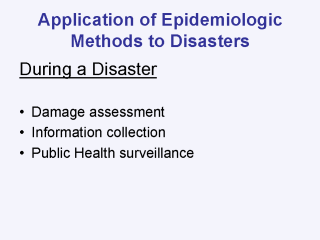| front |1 |2 |3 |4 |5 |6 |7 |8 |9 |10 |11 |12 |13 |14 |15 |16 |review |
 |
The critical
component of any disaster response is the early conduct of a proper damage
assessment to identify urgent needs and to determine relief priorities for
an affected population. Disaster assessment provides relief managers
objective information about the effects of the disaster on a population,
generated on the bases of rapidly conducted field investigators.
The techniques used to collect information (primarily sample and systematic surveys and simple reporting systems) are methodologically straightforward, and if suitable personnel and transportation are available, they should provide reasonably accurate and rapid estimates of the relief needs of disaster-affected populations. Public Health Surveillance is defined as the ongoing, systematic collection, analysis, and interpretation of data on specific health events for use in the planning, implementation, and evaluation of public health programs. |